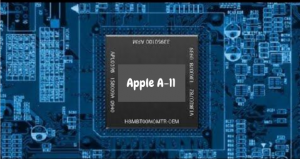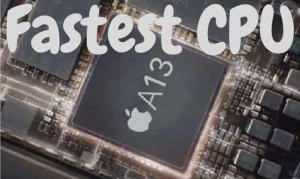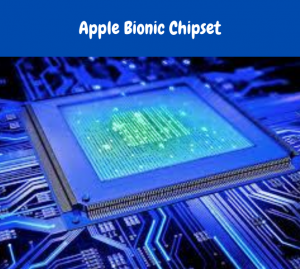Apple Bionic Chipsets
What is the Apple Bionic chip?
The Apple bionic chip or A12 Bionic processor is named on smartphones as among the quickest and effective chips ever. A12 Bionic processor is capable of performing five trillion tasks per second as it includes an eight-core Neural Engine, more than almost any other processor that has been produced thus far.
Figure 1. Apple Bionic chipset
Apple A10 Fusion chipset.
The Apple A10 Fusion is a processor integrated into iPhone 7 and iPhone 7 Plus on a chip (SoC) via Apple. This includes 4 64 Bit cores, split into two groups. Four high-performance nodes are racked up to 2,34 GHz and are projected to be about 40% quicker than that of the Apple A9 (according to Apple) and four low-power cores (up to 1,1 GHz?). Up until now, it is uncertain if all 4 cores could be used simultaneously (in some cases requiring just 1/5th of the power generation). It seems that IOS only uses two clusters at a time when the iPhone 7 is launched and flips between both the two clusters instantly. So, devices may be seeing the dual heart. The concept resembles the large first-generation Weaponry. Apple’s A10 Fusion uses 4-core technology, offering 2x faster bandwidth than that of the iPhone 6. Both layers are Cores with performance improvement. Some other two are low-power cores that drink only 20 percent of the high-performance core’s energy produced. A smart controller can save considerable battery capacity by steering small things to the low-power core.
Apple A10X Fusion chipset.
The Apple A10X Fusion is a processor integrated across Apple’s 2017 iPad Pro models on even a chip (SoC). This contains six 64 Bit modules, split into two clustered. There are triple high-performance cores measured at up to 2,39 GHz. The three battery saving cores can be used for activities that aren’t challenging. It seems like only one of two clusters will run at a time (thus the devices even see three cores). The idea is similar to the huge one. Tiny definition of the first-generation ARMs. The SoC’s output is set in a high and obviously quicker role than any previous Apple (SoC). When compared to Android’s high-end SoCs such as the Snapdragon 835, the A10X comes out on top. The SoC integrated distribution video card would most likely come from Powervar (once more) and includes 12 cores in the A10 SoC, rather than 6. The A10X is produced at TSMC in the brand new 10 nm technology, people suffering from anxiety says. While it provides more feature frames, the A10X is considerably faster than the corresponding A9X (143.9 mm2) with an estimated 96.4 mm2.
Apple A11 Bionic chip.
The Apple A11 Bionic is a processor used in the iPhone 8 Plus, iPhone 8, and iPhone X through an Apple Processor. The announcement was made late in 2017. A11 Bionic, a most talented and capable processor ever on smartphones, includes a six-core CPU architecture with two output cores 25 percent quicker and four reliability core 70 percent higher than the A10 Fusion, providing industry-leading output and power consumption. The A12 Bionic is a hybrid CPU containing a six-core CPU and a quad-core GPU, along with a distinct eight-core processor dedicated to controlling processes of machine learning. Subtitled the ‘Neural Engine,’ this deep learning-centred CPU’s primary priority is to keep a record of the assets on the iPhone models, whether they be CPU or GPU components, to be better suited to handling your instructions, and to also provide external computing power where appropriate. A latest, second-generation quality regulator can continuously leverage all six cores, providing up to 70 percent higher output for multithreaded tasks, giving consumers more energy while going for longer than iPhone 7 for two hours. A11 Bionic also introduces an Apple-designed GPU with a three-core architecture that provides graphics output up to 30 percent bigger than the conventional version. All of this power makes for new innovative machine learning, AR software, and interactive 3D gaming. The latest A11 Bionic neuronal engine is the dual-core architecture and conducts up to 600 billion real-time computing transactions per second. A11 Bionic neural engine is developed for specific algorithms for machine learning which allows for Face ID, Animoji as well as other functions.

Figure 2. Apple A-11 Bionic chip
Apple A12 Bionic chip.
Nonetheless, the new features allowed by that kind of muscular activation would be more measurable. Especially apps that use the corporation’s machine learning models, Core ML, that the new A12 Bionic keeps running nine times stronger than chips over previous. Apple displayed off yet another new Homecourt app on stage, which you can set up to watch you play soccer while tracking the number of shots and throws you produce and fail. Without a crunchy AI processing chip, this kind of real-time analysis is not feasible. The A12 Bionic, more like predecessor the A11 Bionic, development and introduction core processors two so-called output cores and four effectiveness cores. The two performance CPUs are “up to 15 percent quicker” than those discovered in the A11 Bionic, and then use 40 percent less fuel, so according to Apple. The performance cores are just as power-efficient as 50 percent per Apple. This times around, Apple has not reported a performance boost for the utilization cores (last year, Apple reported a 70 percent improvement in capacity cores in the A11 Bionic compared to those from the A10 Fusion), so it seems like Apple is trying to persuade us that the capacity cores in the current A12 Bionic will offer the very same quality as those in the A11 Bionic but use much less e This makes sense given that whole point of the effectiveness cores is to handle activities that are not especially performance-sensitive when using as little effort as possible to optimize battery capacity. A12 Bionic features a composition similar to the A11, apart from that this is the first CPU to be developed using a 7 nm process which makes it considerably quicker than its predecessor. As a consequence, A12 Bionic provides powerful and moving of about 20 percent, the
logic concentration of 1.6X, and power reduction of ~40 percent. In addition, the latest Neural Engine is an octa-core processor that is supposedly capable of performing 5 trillion calculations per second, relative to 600 billion A11-processed calculations per second. The update would make it possible to deploy applications 30 percent faster. Especially apps that use machine learning would benefit from increased results. You should anticipate the latest iPhones to deliver faster Face ID, better picture-mode context recognition, enhanced tracking, and so much more.
Apple A13 Bionic chipset.
Apple unveiled the chip which will drive its latest iPhones: The Bionic A13. And as you’d imagine, the firm doesn’t waste any time demonstrating that it’s the strongest silicon ever to enter inside of a phone just like it has for the past three years each year. Yet if you think about battery capacity, then you’re going to want to pay attention. “The A13 Bionic is the quickest smartphone Processor ever,” Apple stated backstage, stating it also has “the quickest smartphone GPU.” Kaiann Drance, Senior Manager, Product Marketing, iPhone, defined the Apple A13 Bionic as the ‘fastest Processor and GPU ever on a smartphone,’ enabling for impressive capabilities including 4K videos at 60fps with slow-motion photography or ‘selfies’ as well as stereo audio.

Figure 3. Apple A13 Bionic fastest chip
